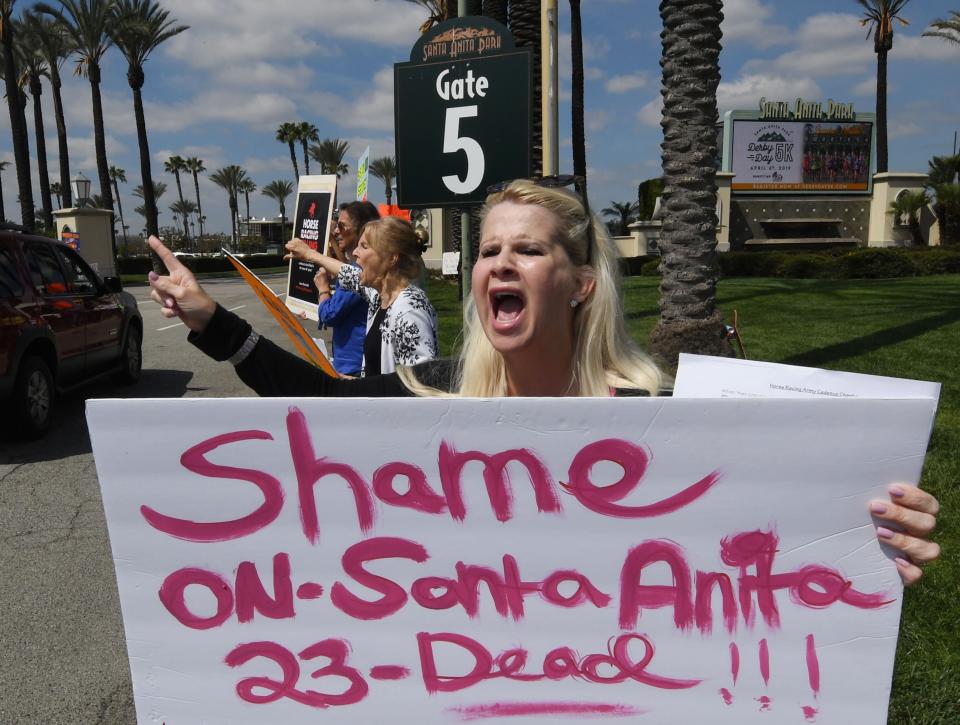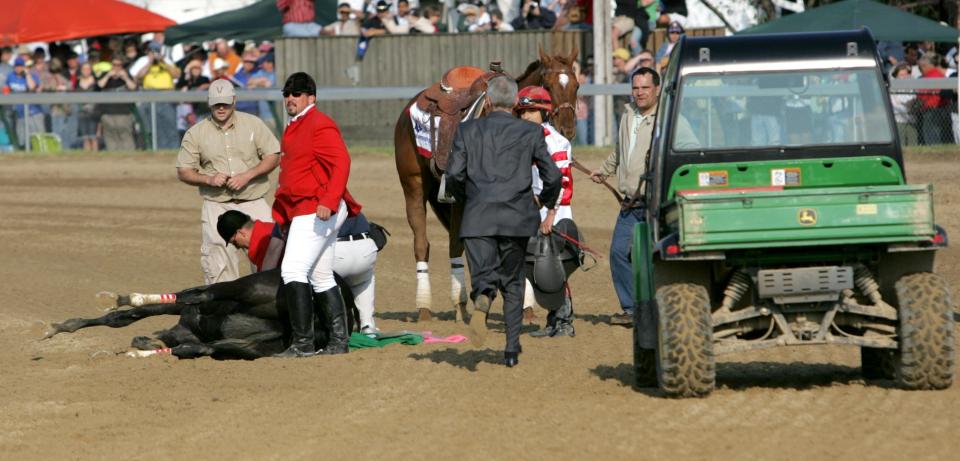Death at the racetrack: Horse racing's big struggle
LOUISVILLE, Ky. — Thoroughbred racing is a sport that crushes more hearts than it melts, a hard-luck game in which the breaks rarely seem to even out. For every Bob Baffert, winner of five Kentucky Derbies and now unexpectedly favored to claim a record-tying sixth, there are 20 Richard Mandellas.
Mandella is the saddest man in the commonwealth this week. The 68-year-old trainer saw the best Derby chance of his life disappear with the scratch of favored Omaha Beach on Wednesday afternoon, after a breathing issue was discovered. On Thursday morning, Mandella was the epitome of stoic dejection — with a dash of gallows humor mixed in — while describing how a day he called “devastating” unfolded.
A cough detected after the colt’s morning gallop. A veterinarian’s throat scope that discovered an entrapped epiglottis. A second opinion confirming the diagnosis. Surgery scheduled. Horse scratched. Dream crushed.
“I went back to the hotel room, sat down, had to gather my thoughts a little bit,” Mandella recalled. “Then I had to call Rick Porter and Wayne Hughes.”
Porter is the owner of Omaha Beach. Hughes is the owner of Spendthrift Farm who just purchased the colt’s breeding rights. The worst part of a trainer’s job is delivering crushing news to clients — and the worst of the worst is crushing Derby news.
The empathy actually flowed both ways during those calls. Last week the 78-year-old Porter, a cancer survivor, acknowledged that “this might be my last shot” at a Derby. He also said Mandella “wants this bad, believe me.” So the two men who have been in the sport forever sought to console one another.
Mandella joked Thursday that his wife, Randi, “tied one leg to the bed so I couldn’t jump out the hotel window.” But when asked if this is the lowest of all lows in his training career, the pause lasted several seconds before he answered.
“I’d say yes,” Mandella responded. “And I guess it’s because the Derby is what it is. And this horse, if you’ve been around the barn, you could see how special he is.”
Indeed, visitors to Churchill Downs Barn 28 were greeted by a beautiful animal with a remarkably kind demeanor. Like a proud father, Mandella loved walking Omaha Beach to the end of the shed row to show him off to visitors, petting his mane and patting his head.
“It just seemed like everything was so in line,” Mandella said. “In fact, I actually had a thought: Is this too perfect? Because nothing is that perfect. We found out what wasn’t. … We came flying in like we had it written on us, and it didn’t work.”
The biggest problem with horse racing is that perfect never seems to last long — especially for the horses themselves. From coughs to foot bruises and every leg bone in between, their fragility is extreme. As the sport struggles to adequately answer hard questions about horse safety, Omaha Beach becomes the latest star sidelined by a health issue.
The good news is that Omaha Beach’s entrapped epiglottis is easily treatable. He should be able to resume his racing career this summer — unless Spendthrift Farm opts to shut him down and send him directly to the breeding shed, with the potential to make millions as a stallion.
Many horses in 2019 have been far less fortunate.
Death on the racetrack

They worked quickly, the two vets removing the broken bones as evidence for the insurance company, the crowd silently watching. Then the heavens opened, the rain pouring down, the lightning flashing, and they rushed for the cover of the stables, leaving alone on his side near the pile of bricks, the rain running off his hide, dead an hour and a quarter after his first start, Air Lift, son of Bold Venture, full brother of Assault. — W.C. Heinz, “Death of a Racehorse”
That grim, spare prose was written 70 years ago, a newspaper column in the New York Sun that lives today for two reasons.
One, the full story is used to teach journalism students the art and craft of deadline reporting and writing.
Two, racehorses are still dying on tracks across America.
From 1949 (earlier, really) to 2019, that has been an accepted part of the sport. Too accepted — or at least it has been, for too long. Horses break legs, horses die, racing moves on. If the fatal injury is prominent enough, there will be public hand-wringing for a while, and calls for change — some of that well intentioned, some of it PR posturing — but the end result remains roughly the same. The business of breeding and medicating and training for speed, speed, speed continues as usual.
At least until now. We may be on the verge of seismic change that, finally, forces racing into business as unusual.
This is Derby Week, the one week of the year when horse racing opens itself up to a wider audience, a national audience, and usually it is a celebration of the sport. But this week, this year, celebration comes within a tragic context.
Dead horses are the news. And dead horses are not something that should just be accepted as part of the bargain.
Racing deaths were specifically and acutely the case this winter at Santa Anita Park in Southern California, one of the anchors of the sport in America. From Christmas Eve through March 30, 23 horses died due to on-track breakdowns at Santa Anita — a number so staggering that it dragged the niche sport into the mainstream news cycle for all the wrong reasons.
The track was shut down for eight days in early March, a damaging blow to both Santa Anita’s business and reputation. Animal rights activists arrived to protest the reopening. A couple more horses died later in the month, and part of the sport seemed to be dying with them.
Many trainers believe the culprit was a racing surface that was lost when California was pummeled by an unusually wet winter. The weather improved this spring, and former track superintendent, Dennis Moore, was brought back to revamp the dirt track. He has produced a deeper and slower racing strip, and eventually the carnage has subsided.
As is so often the case in racing, the sport’s lack of strong, centralized leadership was exposed in a time of crisis. The response to rampant animal deaths was slow, fragmented and wholly inadequate.
Santa Anita itself did not initially embrace accountability before implementing an array of reforms that all have been debated for years. Among the measures: a ban on the use of Lasix, an anti-bleeding medication in common use; and a ban on the use of whips by jockeys. (After pushback from owners, horsemen and jockeys, the reforms were softened.)
“Santa Anita blamed everything but what they were standing on — the ground,” said legendary trainer D. Wayne Lukas. “They blamed everything but the track — Lasix, the whip, medication, motherhood, apple pie.”
But as stories came out about the alarming number of fatal breakdowns at other tracks — including Churchill Downs, one of the most dangerous tracks in America according to the Louisville Courier-Journal — the sport has coalesced behind the notion of reform.
Fact is, the vast majority of people associated with horse racing care deeply about the health and safety of their animals. But it’s also a fact that they are a problematic species — large and fast animals running on thin and delicate legs, and those legs are hard to treat successfully if they break. While the physics of the sport are risky, there is a push to remove additional risk from the equation.
Inbreeding has not been adequately addressed, but drug use to keep infirm animals racing is a prime target at the moment. Most of the nation’s major tracks have agreed to phasing out race-day Lasix use by 2021 — a move that would put U.S. racing more in line with the international approach.
There even is a push for government involvement in the form of the Horseracing Integrity Act, aimed at enlisting the U.S. Anti-Doping Association (USADA) to help regulate a uniform set of standards for medication and testing across the country.
Arthur Hancock, owner of Stone Farm and a member of arguably the most prominent thoroughbred breeding and racing family in America, has been strident on this subject for years. There seem to be more people listening to him now.
“We’ve got to clean up this situation,” Hancock said Tuesday after the Kentucky Derby post-position draw. “We’re the only sport in the world that legally allows our athletes to be drugged. It’s dragging us down with the public.”
Triple Crown tragedy

The Kentucky Derby has been lucky. Very lucky.This will be the 145th running of the race, and there have been very few fatal injuries associated with it. The rest of the Triple Crown has not been so fortunate.
The Preakness has seen its share of tragedy — most notably 1993 fatal breakdown by Union City, and then when 2006 Kentucky Derby winner Barbaro broke down shortly after the start and in full view of the grandstand. After a long effort to save Barbaro, he was euthanized.
The Belmont, too, has had some awful moments. Preakness winner Prairie Bayou shattered a front leg during the 1993 running of the race and could not be pulled up for nearly one-third of a mile after the injury — he was euthanized about 30 minutes later. Charismatic, winner of both the Derby and Preakness in 1999, broke a leg in the stretch of the Belmont. He was at least pulled up quickly after the wire by jockey Chris Antley, and the injury was not fatal.
The worst moment the Derby ever had was in 2008, when filly Eight Belles broke both forelegs after finishing second. The only mitigating factor to that tragedy was that it occurred after Eight Belles had rounded the turn and gotten to the backstretch — out of view of the vast majority of the 157,700 fans in attendance.
If the Eight Belles breakdown had occurred during the social media age, horse racing might not have withstood the outrage prompted by an onslaught of photos and videos pouring into the nation’s consciousness. It was bad enough as it was.
Before and since, the race has been mostly disaster-free. Which, again, is quite lucky. The premise of the largest field of any race in America — a maximum of 20, and expected to be 19 or 20 this year — charging as a pack into the first turn and battling in close quarters for position is slightly terrifying.
If the worst thing that happens this week is an entrapped epiglottis for the favorite, then the Kentucky Derby has again survived its long-running tempting of fate. The sport is under siege, and for good reason. A death to one of the athletes on the biggest stage is the last thing horse racing needs right now.
More from Yahoo Sports:

